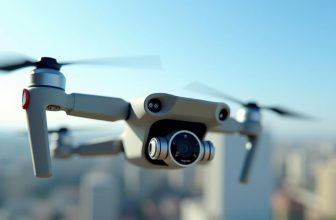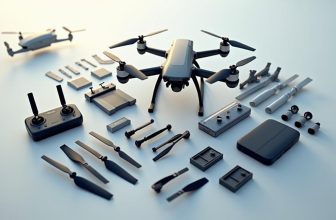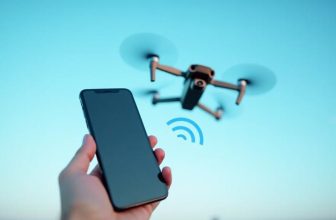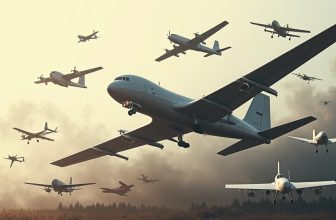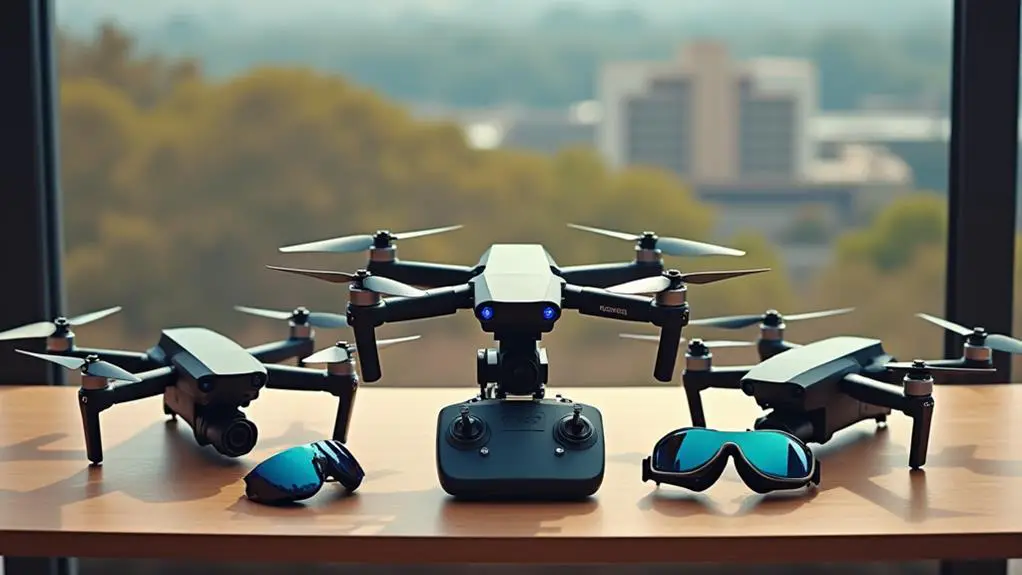
You might be surprised to know that the global drone market is projected to exceed $43 billion by 2025, with more than 20 million drones flying worldwide. As you consider joining this growing community of drone enthusiasts, you’re likely wondering what to look for in a drone that meets your needs. With a vast array of models available, ranging from beginner-friendly quadcopters to high-end aerial photography rigs, making an informed decision can be overwhelming. As you navigate this complex landscape, what key factors should you prioritize to find the perfect drone for your next adventure?
Contents
- 1 Key Takeaways
- 2 Types of Drones Available
- 3 Assessing Your Skill Level
- 4 Drone Size and Weight
- 5 Camera and Video Capabilities
- 6 Flight Time and Range
- 7 Controller and Gimbal Options
- 8 Safety Features and Regulations
- 9 Budget and Price Considerations
- 10 Additional Features to Consider
- 11 Frequently Asked Questions: Ultimate Drone Buying Guide
- 12 Conclusion
Key Takeaways
- Determine your drone’s purpose and pilot experience to choose the right type and features.
- Consider size and weight for portability, performance, and safety.
- Evaluate camera and video capabilities, including resolution, frame rate, and stabilization.
- Assess flight time and range, and consider factors like battery capacity and aerodynamics.
- Check safety features, regulations, and budget to ensure a well-rounded drone purchase.
Types of Drones Available
When shopping for a drone, you’ll encounter various types that cater to distinct needs and preferences.
These drone categories can be broadly classified into several groups, each designed for specific purposes and applications.
You’ll find aerial platforms that specialize in photography and videography, equipped with high-resolution cameras and stabilization systems for smooth footage.
Racing drones, on the other hand, prioritize speed and agility, featuring lightweight frames and powerful motors.
Recreational drones, often considered entry-level models, focus on ease of use and affordability, making them ideal for hobbyists and beginners.
Professional drones, however, are designed for industrial or commercial applications, such as surveying, mapping, and inspection, and often come with advanced features like obstacle avoidance and long-range transmission.
In addition to these categories, you may also encounter drones designed for specific tasks, like aerial mapping, environmental monitoring, or search and rescue operations.
Understanding the different types of drones available will help you make an informed decision based on your specific needs and preferences.
Assessing Your Skill Level
Your choice of drone will be substantially influenced by your skill level as a pilot.
As a beginner, you’ll want a drone that’s easy to handle and forgiving, while experienced pilots can opt for more advanced models with intricate features.
Your pilot experience and flying frequency play a significant role in determining the type of drone that suits you best.
When evaluating your skill level, consider the following factors:
- *Pilot experience*: How long have you been flying drones? If you’re a beginner, look for drones with features like GPS stabilization and altitude hold.
- *Flying frequency*: How often do you plan to fly your drone? If you’re an occasional flyer, a simpler drone with fewer features might be sufficient.
- *Desired level of control*: Do you want complete control over your drone’s movements, or are you comfortable with a more automated experience?
- *Willingness to learn*: Are you enthusiastic to learn new skills and adapt to complex drone systems, or do you prefer a more straightforward flying experience?
Drone Size and Weight
Medium-sized drones, weighing between 250 grams and 1 kilogram, strike a balance between portability and performance.
They’re often used for recreational purposes and may feature foldable designs for added convenience.
Larger drones, weighing over 1 kilogram, are typically used for professional applications, such as aerial photography and mapping.
They offer greater stability and longer flight times but are often less portable due to their size and weight.
When choosing a drone, consider its size and weight in relation to your specific needs and usage.
This will help you find a drone that balances performance, portability, and safety.
Camera and Video Capabilities
When evaluating a drone’s camera and video capabilities, you’ll want to ponder several key factors.
Resolution and frame rate are vital for capturing smooth, high-quality footage, so look for drones that offer high-definition resolutions (such as 4K) and frame rates of at least 30 fps.
Additionally, you’ll also need to think about stabilization and gimbal control, as well as sensor and lens quality, to guarantee your drone can produce professional-grade video and photos.
Resolution and Frame Rate
To capture high-quality footage, one must take into account a drone’s camera resolution and frame rate.
These two factors greatly impact the overall video quality and the types of shots you can capture. Resolution refers to the number of pixels in the camera’s sensor, which directly affects the level of detail in your footage. A higher resolution means a higher pixel density, resulting in sharper images.
When considering frame rate, you must think about the type of footage you want to capture.
A higher frame rate, typically 60fps or above, is ideal for fast-paced scenes or slow motion capture.
Resolution and frame rate are vital considerations:
- *Resolution:* Look for a camera with a high resolution (at least 1080p) for crisp and detailed footage.
- *Frame rate:* A minimum of 30fps is recommended for most applications, but 60fps or higher is ideal for smooth and dynamic footage.
- *Slow motion capture:* If you want to capture slow-motion footage, look for a drone with a high frame rate (at least 120fps) and a high resolution.
- *Codec and bitrate:* Consider a drone that can record in a high-quality codec (such as H.264 or H.265) and offers a high bitrate (at least 100 Mbps) for superior video quality.
Stabilization and Gimbal Control
You’ve likely experienced the frustration of shaky or unstable footage when flying a drone, which is why stabilization and gimbal control are crucial camera and video capabilities to ponder.
These features work in tandem to guarantee smooth and stable video capture, even during intense maneuvers.
At the heart of stabilization systems are gyroscopes, which use angular momentum to measure the drone’s orientation and movement.
This data is then used to adjust the camera’s position and maintain a steady shot. Gyroscopes explained, they’re basically sensors that help the drone’s flight control system make precise adjustments to maintain stability.
Effective stabilization also relies on electronic leveling, which uses sensors and algorithms to automatically adjust the camera’s roll, pitch, and yaw.
This confirms that the horizon remains level and the footage is free from unwanted tilts or dips.
When evaluating a drone’s stabilization and gimbal control capabilities, look for features like multi-axis gimbals, which allow for smooth panning and tilting, and advanced stabilization algorithms that can adapt to changing flight conditions.
Sensor and Lens Quality
Most high-end drones boast at least a 1/2.3-inch image sensor, but one-inch sensors have become increasingly popular in recent years, offering improved low-light performance and enhanced color accuracy.
As you consider your drone options, keep in mind that sensor size isn’t everything – sensor sensitivity also plays a significant role in determining image quality. A more sensitive sensor can capture more light, resulting in better low-light performance and reduced noise.
When evaluating a drone’s camera capabilities, look for the following key features:
- Lens distortion: A higher-quality lens with minimal distortion will provide a more accurate representation of the scene.
- Sensor size: A larger sensor generally offers better low-light performance and enhanced color accuracy.
- Aperture: A wider aperture (represented by a lower f-stop number) allows more light to enter the camera, resulting in better low-light performance.
- Field of view: A wider field of view can be beneficial for capturing sweeping landscapes or tracking fast-moving subjects.
Ultimately, the quality of the sensor and lens will have a significant impact on the overall image quality of your drone’s camera.
Flight Time and Range
Your drone’s flight time and range are critical factors in determining its overall performance and suitability for various applications.
When evaluating these factors, consider the drone’s power source, efficiency, and aerodynamics. For extended flights, look for drones with high-capacity batteries that can provide a longer flight time.
Typically, drones with larger batteries offer more flight time, but this may also affect their agility and portability.
If you plan to use your drone for long-distance flights, consider the transmission range and signal strength. A strong signal is essential for maintaining a stable connection between the drone and the controller.
Look for drones with advanced transmission systems that can transmit signals over long distances without interruption. Additionally, consider drones with GPS and GLONASS capabilities, which enable more precise navigation and tracking.
When evaluating flight time and range, also consider the drone’s weight, propeller efficiency, and drag. Drones with optimized aerodynamics and efficient propellers can achieve longer flight times and greater ranges.
Controller and Gimbal Options
The controller, often considered the drone’s brain, plays a vital role in determining your flying experience.
When choosing a controller, consider its ergonomics, verifying it fits comfortably in your hands, allowing for precise control and minimal fatigue during extended flights.
Look for adjustable grips and well-placed buttons to suit your flying style.
The controller’s design should also accommodate your phone or tablet, providing a secure and adjustable mount.
Some controllers feature a built-in screen, eliminating the need for a separate device.
Gimbal options are also vital, as they determine the quality of your aerial footage.
Consider the following factors when selecting a gimbal:
- Gimbal material: Carbon fiber or aluminum gimbals offer durability and resistance to corrosion.
- Gimbal type: 2-axis or 3-axis gimbals provide varying levels of stabilization and camera movement control.
- Camera compatibility: Verify the gimbal is compatible with your camera, considering factors like weight and size.
- Adjustable settings: Look for gimbals with adjustable settings, such as pan and tilt speed, to fine-tune your footage.
Safety Features and Regulations
Safety concerns often arise when operating drones, as they can pose a risk to people, animals, and property.
To mitigate these risks, verifying the safety features of your drone is crucial. Look for drones with obstacle avoidance systems, which use sensors to detect and avoid potential hazards. Some drones also come equipped with geofencing, a feature that restricts flight within designated areas.
Before operating your drone, familiarize yourself with airspace rules in your area. These rules vary by country and region, but generally include restrictions on flying near airports, national parks, and other sensitive areas.
You’ll also want to guarantee you have the necessary permits and licenses to operate your drone.
Drone insurance is another important factor to ponder. Many drone manufacturers offer insurance options that cover damage to your drone, as well as liability for damage to people or property.
It’s also a good idea to check if your homeowner’s or renter’s insurance policy covers drone-related incidents. By understanding and adhering to safety regulations and investing in drone insurance, you can minimize the risks associated with drone operation.
Research and compliance are key to safe and responsible drone ownership.
Budget and Price Considerations
When setting a budget for a drone, consider not just the upfront cost, but also ongoing expenses like maintenance, repairs, and accessories.
This will help you get a clear picture of the total cost of ownership and guarantee you’re not caught off guard by unexpected expenses.
When determining your budget, it’s vital to prioritize your financial priorities.
If you’re a hobbyist, you may be able to get by with a lower-cost drone. However, if you’re planning to use your drone for professional purposes, such as aerial photography or surveying, you’ll likely need to invest in a more expensive model.
When evaluating your cost constraints, consider the following:
- *Upfront cost*: The initial purchase price of the drone, including any bundles or promotions.
- *Maintenance and repairs*: The cost of replacement parts, labor, and any maintenance or repair services you may need.
- *Accessories and upgrades*: The cost of any additional accessories or upgrades you may want, such as extra batteries or a higher-resolution camera.
- *Operating costs*: The cost of fuel, electricity, or other expenses associated with operating your drone.
Additional Features to Consider
Precision and versatility are key to getting the most out of your drone.
When weighing additional features, think about how you plan to use your drone and what would enhance your experience. If you’re an aerial photographer or videographer, look for drones with advanced camera features like 3D modeling, mapping, or live streaming capabilities.
Other features to ponder include Follow Me mode, which allows your drone to track and follow you, and Obstacle Avoidance systems, which use sensors and cameras to detect and avoid obstacles.
These features can be especially useful for beginners or those who plan to fly in complex environments.
GPS and GLONASS support can also improve your drone’s navigation and stability.
Ponder drones with multiple flight modes, such as sport mode or cinematic mode, to give you more control over your flight experience.
Additionally, look for drones with advanced safety features like automatic emergency landing or return-to-home functionality.
Frequently Asked Questions: Ultimate Drone Buying Guide
Can I Fly a Drone in National Parks and Forests?
You’ll need to research specific park rules and forest permissions before flying a drone in these areas, as regulations can vary, and some parks may require special permits or have no-fly zones to protect wildlife and visitors.
Are Drone Insurance Policies Worth the Investment?
“An ounce of prevention is worth a pound of cure.” When evaluating drone insurance, you weigh risk assessment and financial protection. Policies can safeguard your assets, mitigate losses, and provide peace of mind in case of accidents or damage.
How Do I Update My Drone’s Software and Firmware?
You’ll update your drone’s software and firmware by checking the manufacturer’s site for latest firmware versions, ensuring software compatibility, and following the provided step-by-step instructions to prevent potential system crashes or data loss.
Can I Attach a Third-Party Camera to My Drone?
About 70% of drone users upgrade their cameras. You can attach a third-party camera to your drone, but check camera compatibility first. Verify the lens quality matches or exceeds your drone’s original specs.
Do I Need to Register My Drone With the FAA Internationally?
When flying abroad, you’ll need to comply with international laws, but you don’t need a “drone passport” per se. You’ll need to register your drone with the FAA, then research and adhere to each country’s regulations.
Conclusion
As you stand at the threshold, remote control in hand, the world of possibilities unfolds. Your perfect drone awaits, its rotors whispering secrets of breathtaking vistas and uncharted skies. Will you open the gates to aerial mastery, or succumb to the void of uncertainty? The choice is yours. With this guide, you’ve got the keys – now take the leap, and let the drone revolution sweep you up in its vortex of innovation and discovery.



